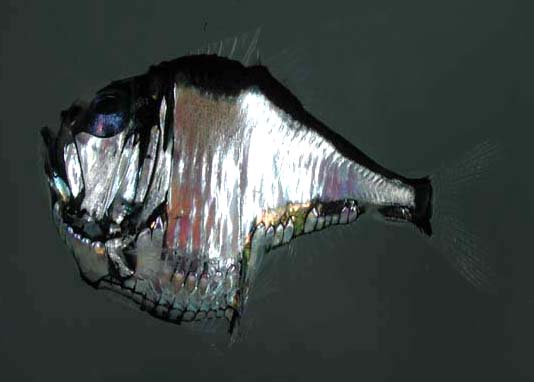Marine Hatchetfish (Family: Sternoptychidae) - Wiki Marine hatchetfish
From Wikipedia, the free encyclopedia
[Photo] Lovely or silver hatchetfish (Argyropelecus aculeatus).Source: NOAA Ocean Explorer http://oceanexplorer.noaa.gov/explorations/islands01/log/sep23/media/hatchet_fish.html
Marine hatchetfish are big, deep-sea bathypelagic fish of the family Sternoptychidae, together with bottlelights, pearlsides and constellationfish. They should not be confused with the freshwater hatchetfish, an unrelated family (Gasteropelecidae) of characins.
Found most often at depths of 200-6000 meters in tropical and subtropical waters of the Atlantic, Pacific and Indian Oceans, marine hatchetfish grow from ca. 2.8 cm long in Polyipnus danae to ca. 2 feet long in giant hatchetfish (Argyropelecus gigas).
Like the freshwater varieties, marine hatchetfish are named for their laterally compressed and deeply keeled bodies, somewhat resembling a hatchet blade (with the caudal peduncle being the "handle"). Species of the genus Polyipnus are more rounded in outline. Their bodies are covered in delicate silvery scales which abrade easily. In some species, such as the highlight hatchetfish (Sternoptyx pseudobscura), large sections of the body at the base of the anal fin and/or caudal (tail) fin are transparent.
Their large, tubular eyes collect the faintest of light and focus well on targets both close and far. However, the eyes are permanently fixed gazing upwards (although less so in Sternoptyx species): This is an indication that hatchetfish look for the silhouettes of prey moving overhead in the gloom. Other animals do the same, so the hatchetfish has developed a clever strategy to combat predators: counterillumination.
Counterillumination (or counter-lighting) involves the production of light by the fish for the purpose of camouflaging its silhouette from predators lurking below. Hatchetfish produce this light with organs called photophores: the fish have a number of them on their bellies and lower flanks (see bioluminescence). The intensity of the light produced is controlled by the hatchetfish, an appropriate brightness chosen according to how much light reaches the eyes from above. The patterns of light created by the photophores are also unique to each species, probably playing a role in courtship.
Hatchetfish undertake nightly migrations en masse, from depths of 3,600 metres to the upper 50-100 metres of the starlit water column. There they feed throughout the night, returning to the depths by daybreak. Their prey consists primarily of tiny copepods, amphipods, ostracods, euphausiids and other fish.
What little is known of their life cycle suggests some species of hatchetfish lead brief lives, no longer than a year. The fry are morphologically different from the adults, appearing more or less like the elongate pearlsides.
http://en.wikipedia.org/wiki/Marine_hatchetfish
| The text in this page is based on the copyrighted Wikipedia article shown in above URL. It is used under the GNU Free Documentation License. You may redistribute it, verbatim or modified, providing that you comply with the terms of the GFDL. |
